Joint Stress Analysis of the Navicular Bone of the Horse and Its Implications for Navicular Disease
Abstract
:1. Introduction
2. Materials and Methods
- (A)
- Radiographs
- (B)
- Biomechanical principles
- (C)
- Mathematical analysis
- (a)
- FS or FL, whichever is required for the moment equilibrium, normalised to FT;
- (b)
- FJ, normalised to FT;
- (c)
- The direction of FJ in terms of the angle φ;
- (d)
- The position of FJ at the articular surface (centre of pressure, COP; Figure 3);
- (e)
- The articular surface pressure P.
- (1)
- Moment equilibrium about the rotation centre of the hoof joint
- (2)
- Force equilibrium:
- (3)
- Joint forces:
- (4)
- Direction of the joint force and position of the centre of pressure (COP):
- (5)
- Calculation of the pressure distribution on the articular surface:
- (a)
- The sum of Pθ (times unit area) is equal to FJ; more specifically, the sum of Pθx′ (times unit area), the Pθ-component perpendicular to FJ, is equal to 0 (force equilibrium), and the sum of Pθy′ (times unit area), the Pθ-component parallel to FJ, is equal to FJ;
- (b)
- The sum of Pθ-moments about the COP is equal to 0 (moment equilibrium); the moment arm l of Pθ is the shortest distance between Pθ and the COP.
- (D)
- Regression analysis
3. Results
- (A)
- Morphological parameters
- (B)
- Biomechanical parameters.
- (1)
- The normalised magnitude of the joint forces FJ, FS, and FL;
- (2)
- The position of the COP.
- (3)
- The normalised magnitude of the peak stress vector;
- (4)
- The stress distribution (even or uneven).
- -
- -
- At its underside, where the navicular bone is in contact with the deflected DDFT by the force FC (Figure 2).
- -
- If p50/d > 1, then the distal impar ligament (tensile force FL) is under tension;
- -
- If p50/d < 1, then it is loaded with pronounced compressive force FS at the NDP joint (B in Figure 1).
- (a)
- Joint force FJ:
- (b)
- COP:
- (c)
- Stress at the distal edge of the navicular bone (Pdist_eff):
- -
- P0 within the articular surface: peak pressure at P0, where θdist is positive, and θprox is negative;
- -
- P0 outside the articular surface on proximal side: peak pressure at Pprox, where both θdist and θprox are positive;
- -
- P0 outside the articular surface on distal side: peak pressure at Pdist, where both θdist and θprox are negative.
- (1)
- Increase p50;
- (2)
- Increase γ;
- (3)
- Both strategies 1 and 2 imply a reduction of μ (since both p50/d and γ are negatively correlated with μ) and, thereby, rotate the navicular bone in the proximal direction.
4. Discussion
- (1)
- The stress distribution across the articular surface was not modeled based on Hertzian stress because the joint surfaces are composed of hyaline cartilage, characterised by low elastic modulus and viscoelastic properties. In addition, a clearance between the corresponding joint surfaces, i.e., the difference in radii of curvature, was not considered either due to the above-mentioned properties and due to the lubrication with synovia, a viscous fluid.
- (2)
- There is no conclusive evidence available in the literature that increased stress on the navicular bone is the primary cause of navicular disease. There is some circumstantial evidence based on clinical studies. Wilson et al. [16] found that the force exerted on the navicular bone by the DDFT was twice as large in the diseased cohort as in the control group. The reason for this finding was unspecified heel pain that forced the pressure centre on the sole of the hoof into a cranial position to relieve the pain. The cranial position of the centre of pressure, in turn, increased the moment arm of the ground reaction force at the coffin joint and, therefore, also the force of the DDFT, thereby compressing the navicular bone more than usual. Analgesia of the palmar digital nerves reversed this mechanism, and the calculated force acting on the navicular bone decreased [31]. However, the cause of this pathobiomechanical mechanism of unloading the heel coupled with overloading of the navicular bone cannot logically and conclusively lie in a painful navicular disease. Accordingly, McGuigan and Wilson [31] correctly state that “this mechanism identifies navicular disease as a possible end point for a variety of heel related conditions.” However, the most important conclusion related to this mechanism is that in two horses with similarly overloaded navicular bones, as a result of relief from heel pain, the horse with a more wedge-shaped navicular bone is likely to experience greater stress on the articular surfaces and inside the navicular bone. Bentley et al. [13] found that navicular disease is associated with “high microcrack surface density”. Due to these circumstances, this study can only suggest that there is a higher risk of navicular disease if Pdist_eff is large, specifically in navicular bones with adverse morphology. This study, in turn, represents an appropriate method to initiate an expanded study of the cause of navicular disease by examining horses diagnosed with navicular disease based on radiological signs and/or significant lameness. The proposed method outlined in this study is independent of actual ground reaction forces (which are obviously smaller in the lame limb) since the forces of the model are normalised to the DDFT force. Caution is advised when it comes to the training load on a horse, as frequent overloading of the navicular bone, e.g., in gallopers or trotters, can theoretically lead to disease in the navicular bone despite ideal morphological conditions.
- (3)
- The multiple regressions calculated to examine the influence of morphological parameters on biomechanical parameters were performed with two predictors, even if the number of morphological parameters was three (γ, μ, and p50/d). Multiple regression with three predictors would be the method of choice, although the above-mentioned problems with negative shared variance with three predictors would be more complex, making interpretation difficult.
5. Conclusions
Funding
Institutional Review Board Statement
Informed Consent Statement
Data Availability Statement
Conflicts of Interest
References
- Rooney, J.R. Biomechanics of Lameness in Horses; Williams & Wilkins: Baltimore, MD, USA, 1969; pp. 77–98, 181–186. [Google Scholar]
- Bartel, D.L.; Schryver, H.F.; Langrana, N.; Lowe, J.E. Locomotion in the horse. A procedure for computing the internal forces in the digit. Am. J. Vet. Res. 1978, 39, 1721–1727. [Google Scholar]
- Adams, O.R. A review of treatment for navicular disease. In Proceedings of the 20th Annual Meeting of the American Association of Equine Practitioners, Las Vegas, NV, USA, 3–5 December 1974; pp. 47–59. [Google Scholar]
- Colles, C.M. Navicular disease and its treatment. Equine Pract. 1982, 4, 29–36. [Google Scholar] [CrossRef]
- Trotter, G. The biomechanics of what really causes navicular disease. Equine Vet. J. 2001, 33, 334–336. [Google Scholar] [CrossRef]
- Stashak, T.S. Navicular syndrome. In Adam’s Lameness in Horses, 5th ed.; Stashak, T.S., Ed.; Lippincott Williams and Wilkins: Philadelphia, PA, USA, 2002. [Google Scholar]
- Stashak, T.S. Adams’ Lameness in Horses, 4th ed.; Lea & Febiger: Philadelphia, PA, USA, 1987. [Google Scholar]
- Bos, H.; van der Meij, G.J.; Dik, K.J. Heredity of navicular disease. Vet. Quart. 1986, 8, 68–72. [Google Scholar] [CrossRef] [PubMed]
- Ueltschi, G.; Hornig, I.; Stornetta, D. Beobachtungen zur Genetik der Podotrochlose. In Orthopädie bei Huf-und Klauentieren; Knezevic, P.F., Ed.; Schattauer: Stuttgart, Germany, 1995; pp. 52–61. [Google Scholar]
- Rijkenhuizen, A.B.; Németh, F.; Dik, K.J.; Goedegebuure, S.A. The arterial supply of the navicular bone in adult horses with navicular disease. Equine Vet. J. 1989, 21, 418–424. [Google Scholar] [CrossRef] [PubMed]
- Rijkenhuizen, A.B.M. Die arterielle Blutgefäßversorgung des Strahlbeines und ihre Beziehung zur Podotrochlose. Pferdeheilkunde 1990, 6, 253–260. [Google Scholar] [CrossRef]
- Colles, C.M.; Hickman, J. The arterial supply of the navicular bone and its variation in navicular disease. Equine Vet. J. 1977, 9, 150–154. [Google Scholar] [CrossRef] [PubMed]
- Bentley, V.A.; Sample, S.J.; Livesey, M.A.; Scollay, M.C.; Radtke, C.L.; Frank, J.D.; Kalscheur, V.L.; Muir, P. Morphologic changes associated with functional adaptation of the navicular bone of horses. J. Anat. 2007, 211, 662–672. [Google Scholar] [CrossRef] [PubMed]
- Dik, K.J.; van den Broek, J. Role of navicular bone shape in the pathogenesis of navicular disease: A radiological study. Equine Vet. J. 1995, 27, 390–393. [Google Scholar] [CrossRef] [PubMed]
- Hinkle, F.; Barrett, M. CPD article: Radiographic interpretation of the navicular bone: A review. UK-Vet Equine 2020, 4, 136–143. [Google Scholar] [CrossRef]
- Wilson, A.M.; McGuigan, M.P.; Fouracre, L.; MacMahon, L. The force and contact stress on the navicular bone during trot locomotion in sound horses and horses with navicular disease. Equine Vet. J. 2001, 33, 159–165. [Google Scholar] [CrossRef] [PubMed]
- Fuss, F.K.; Fuss, A.H. Biomechanical factors for the aetiology of navicular disease in sports horses. In Proceedings of the 16th ISBS (International Society of Biomechanics in Sports) Symposium, Konstanz, Germany, 21–25 July 1998; Riehle, H., Vieten, M., Eds.; UVK: Konstanz, Germany, 1998; pp. 26–29. [Google Scholar]
- Clayton, H.M. No foot—No horse. Anvil 1987, 12, 16–18. [Google Scholar]
- Denoix, J.M. Functional anatomy of tendons and ligaments in the distal limbs (manus and pes). Vet. Clin. N. Am. Equine Pract. 1994, 10, 273–322. [Google Scholar] [CrossRef] [PubMed]
- Butcher, M.T.; Bertram, J.E.A.; Benzuidenhout, A.J. Collateral ligaments of the distal sesamoid bone in the digit of Equus: Re-evaluating midstance function. J. Morphol. 2006, 267, 1177–1185. [Google Scholar] [CrossRef] [PubMed]
- Brinckmann, P.; Frobin, W.; Hierholzer, E. Stress on the articular surface of the hip joint in healthy adults and persons with idiopathic osteoarthrosis of the hip joint. J. Biomech. 1981, 14, 149–156. [Google Scholar] [CrossRef] [PubMed]
- Fuss, F.K.; Weizman, Y.; Niegl, G.; Tan, A.M. Climbers’ perception of hold surface properties: Roughness versus slip resistance. Front. Psychol. 2020, 11, 252. [Google Scholar] [CrossRef] [PubMed]
- James, G.; Witten, D.; Hastie, T.; Tibshirani, R. An Introduction to Statistical Learning: With Applications in R; Springer: New York, NY, USA, 2013. [Google Scholar]
- Schneider, R.K.; Gavin, P.R.; Tucker, R.L. What MRI is teaching us about navicular disease. In Proceedings of the 49th Annual Convention of the American Association of Equine Practitioners, New Orleans, LA, USA, 21–25 November 2003; Available online: http://www.ivis.org/proceedings/AAEP/2003/schneider/ivis.pdf (accessed on 6 August 2023).
- Colles, C.M. Ischaemic necrosis of the navicular bone and its treatment. Vet. Rec. 1979, 104, 133–137. [Google Scholar] [CrossRef] [PubMed]
- Willemen, M.A.; Savelberg, H.H.; Barneveld, A. The effect of orthopaedic shoeing on the force exerted by the deep digital flexor tendon on the navicular bone in horses. Equine Vet. J. 1999, 31, 25–30. [Google Scholar] [CrossRef] [PubMed]
- Constantinescu, G.M. Illustrated Veterinary Anatomical Nomenclature, 4th ed.; Thieme: Stuttgart, Germany, 2018. [Google Scholar]
- Duffy, P.; Arabaolaza, I.; Kilpatrick, M. Draft report: The Human Remains from the St. Nicholas Uniting, Aberdeen; GUARD osteoarchaeological report; GUARD Archaeology Ltd.: Glasgow, Scotland, 2008. [Google Scholar]
- Yeung, J.E.; Chu, G.H.; DeLustro, F.A.; Rhee, W.M. Anti-Adhesion Films and Compositions for Medical Use. European Patent Specification EP 0 732 110 B1, 24 October 2001. [Google Scholar]
- Owen, R. On the Archeopteryx of Von Meyer, with a Description of the Fossil Remains of a Long-Tailed Species, from the Lithographic Stone of Solenhofen. Philos. Trans. R. Soc. Lond. 1863, 153, 33–47. [Google Scholar]
- McGuigan, M.P.; Wilson, A.M. The effect of bilateral palmar digital nerve analgesia on the compressive force experienced by the navicular bone in horses with navicular disease. Equine Vet. J. 2001, 33, 166–171. [Google Scholar] [CrossRef] [PubMed]
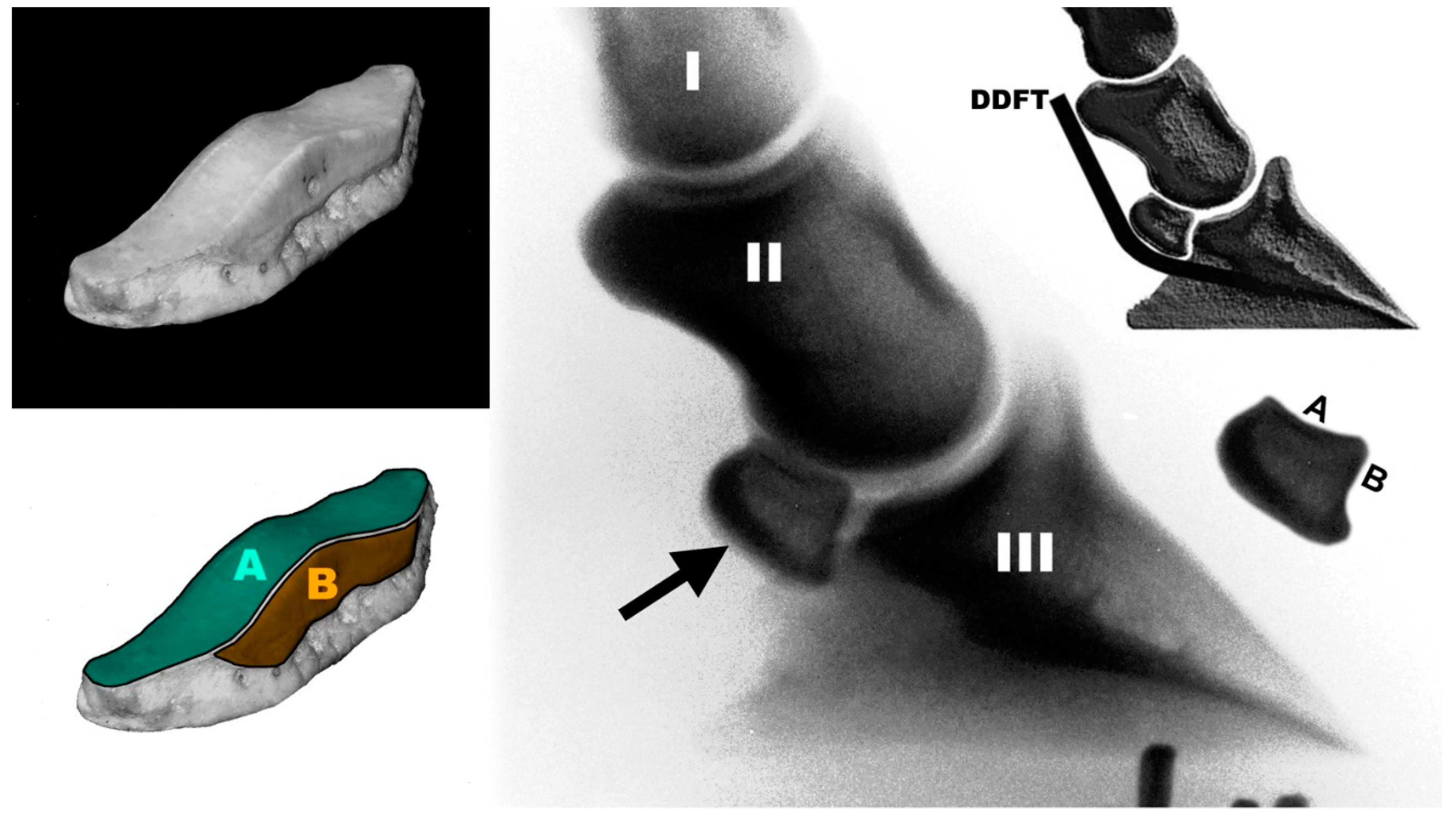
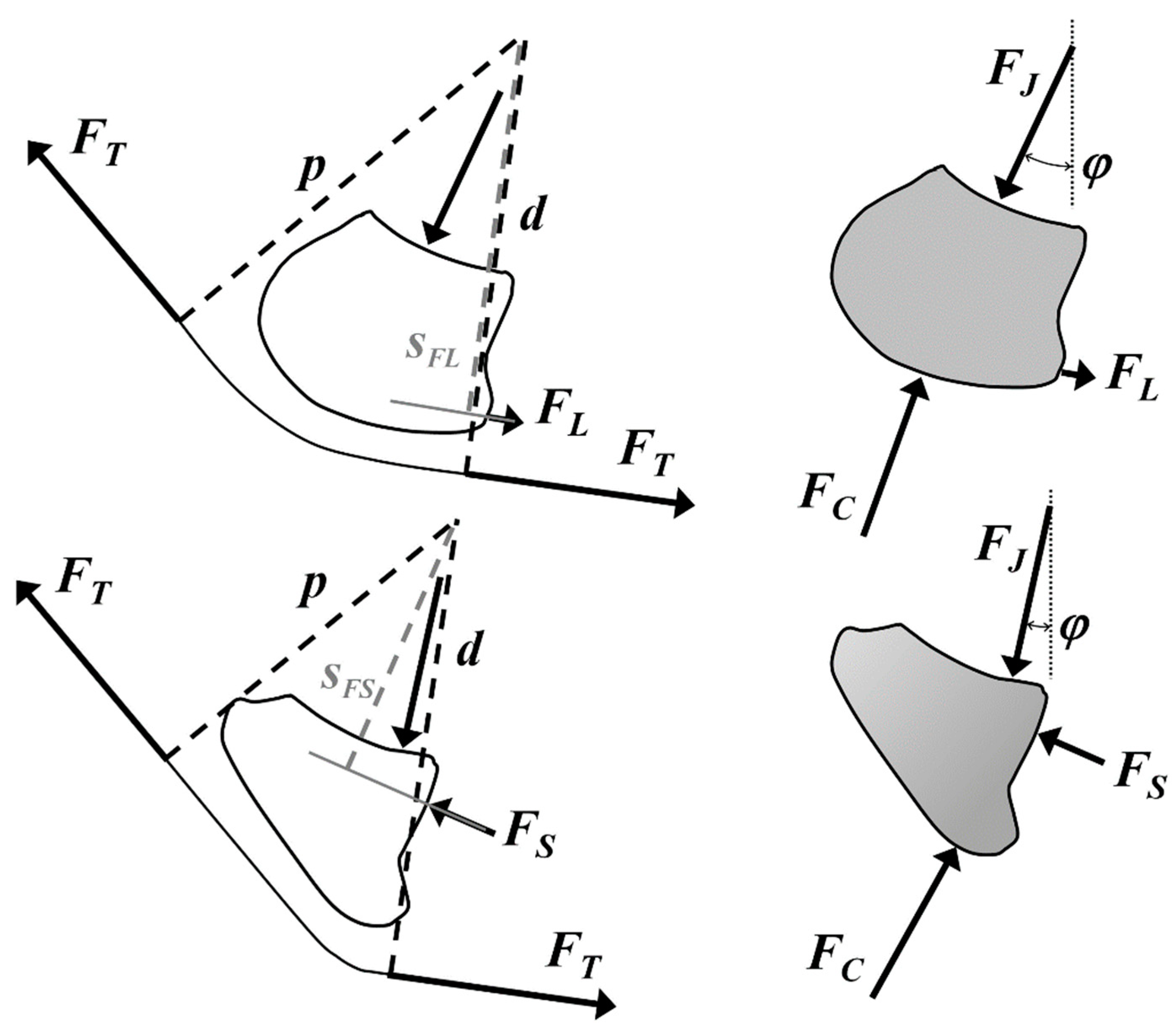
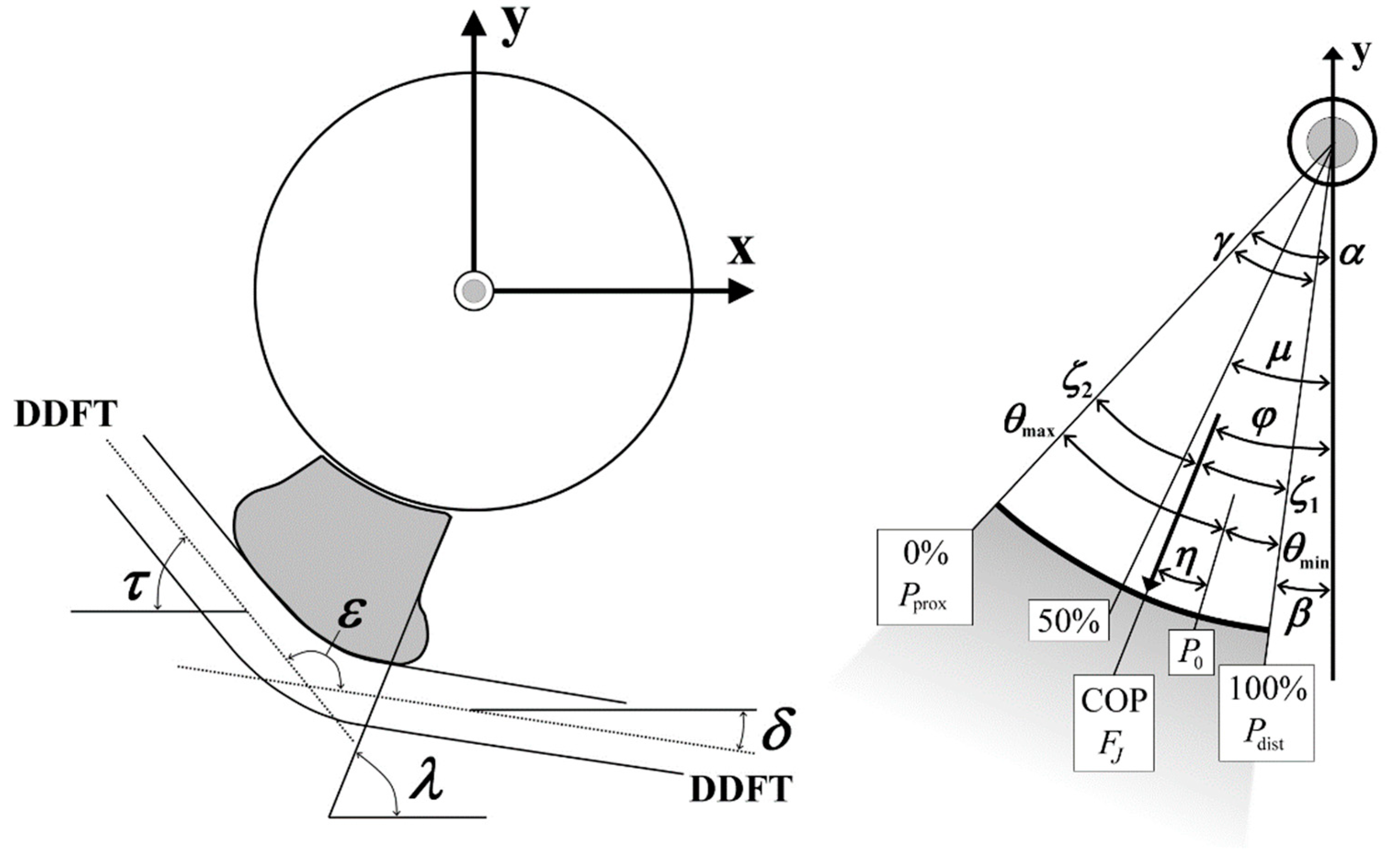
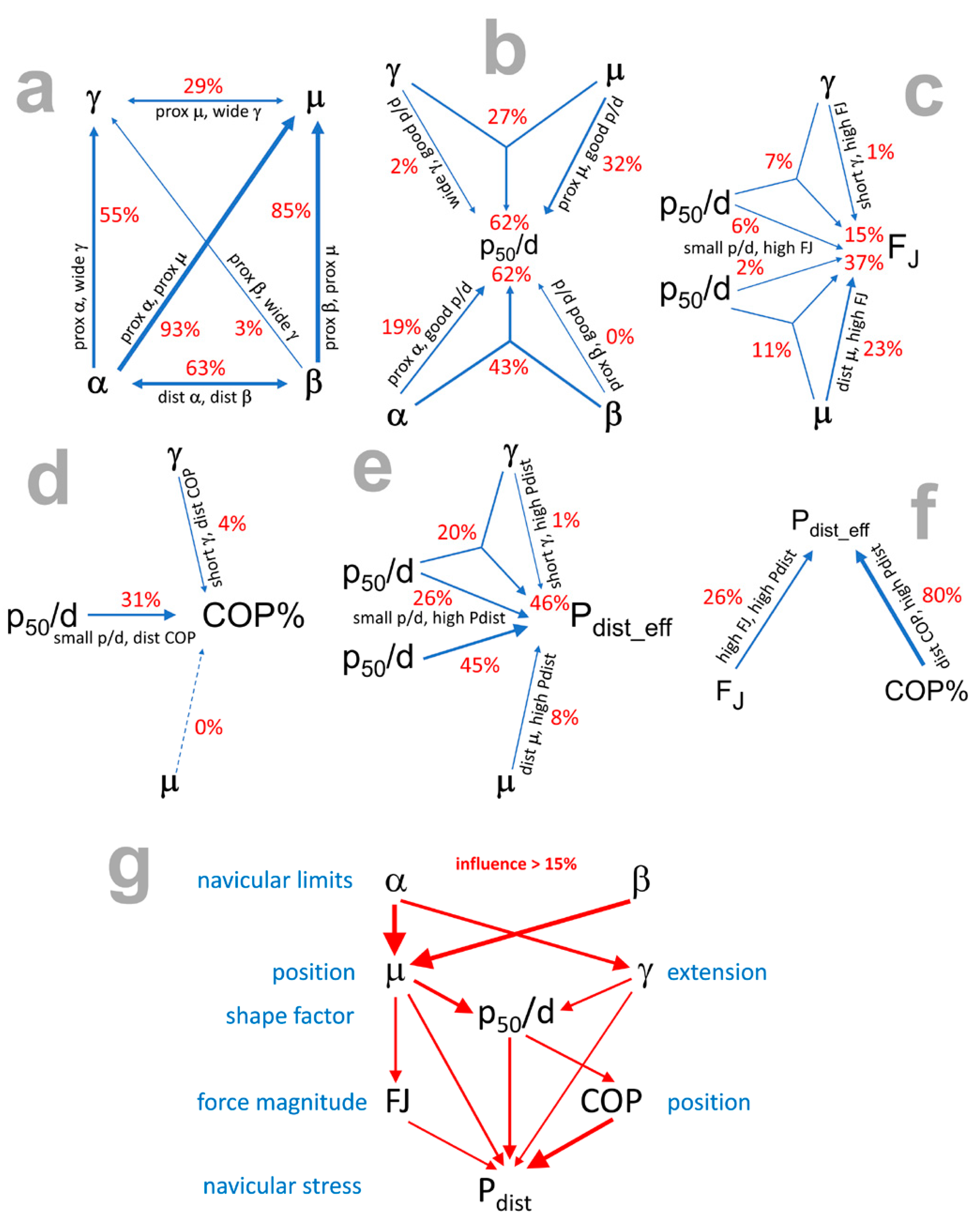

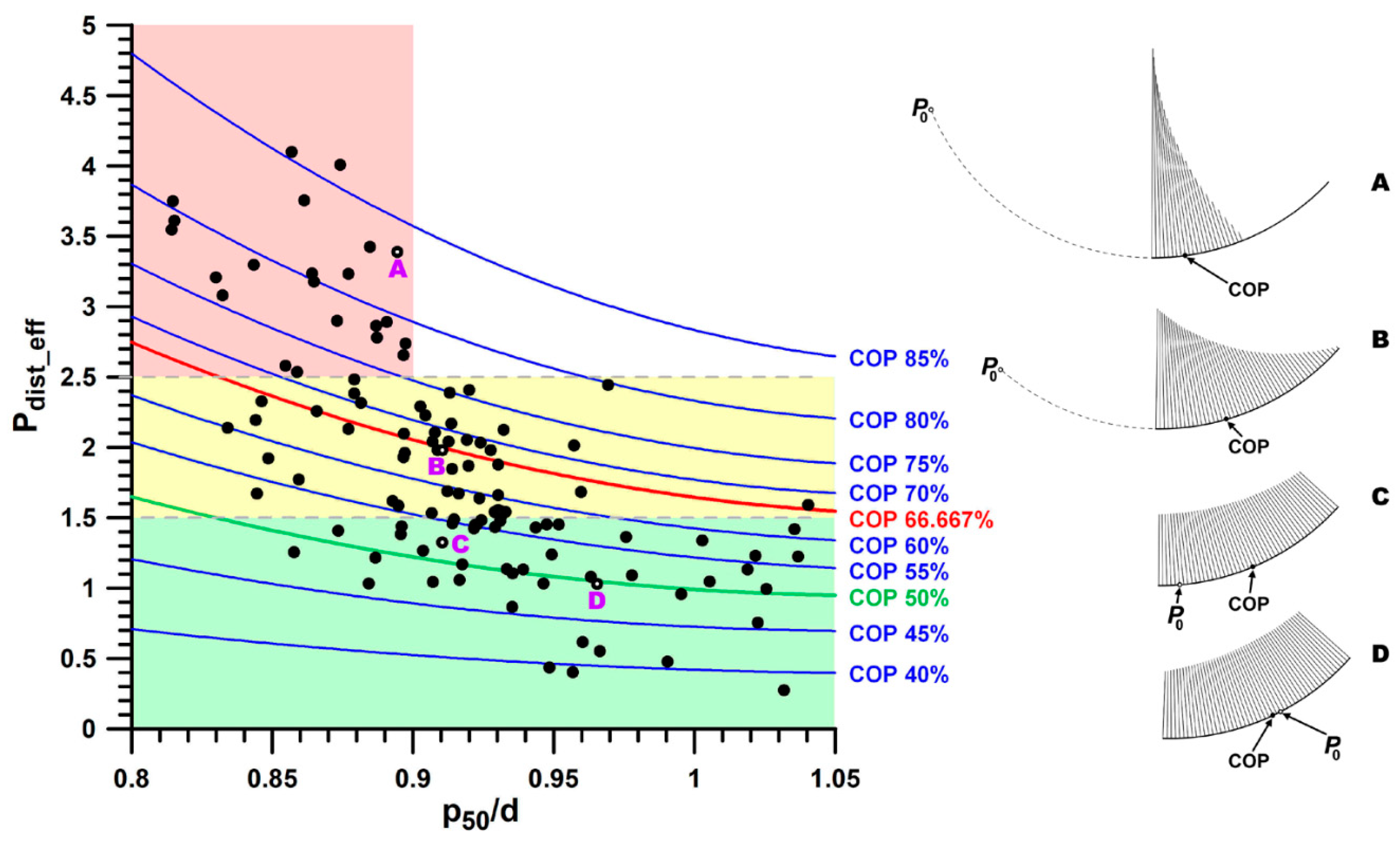
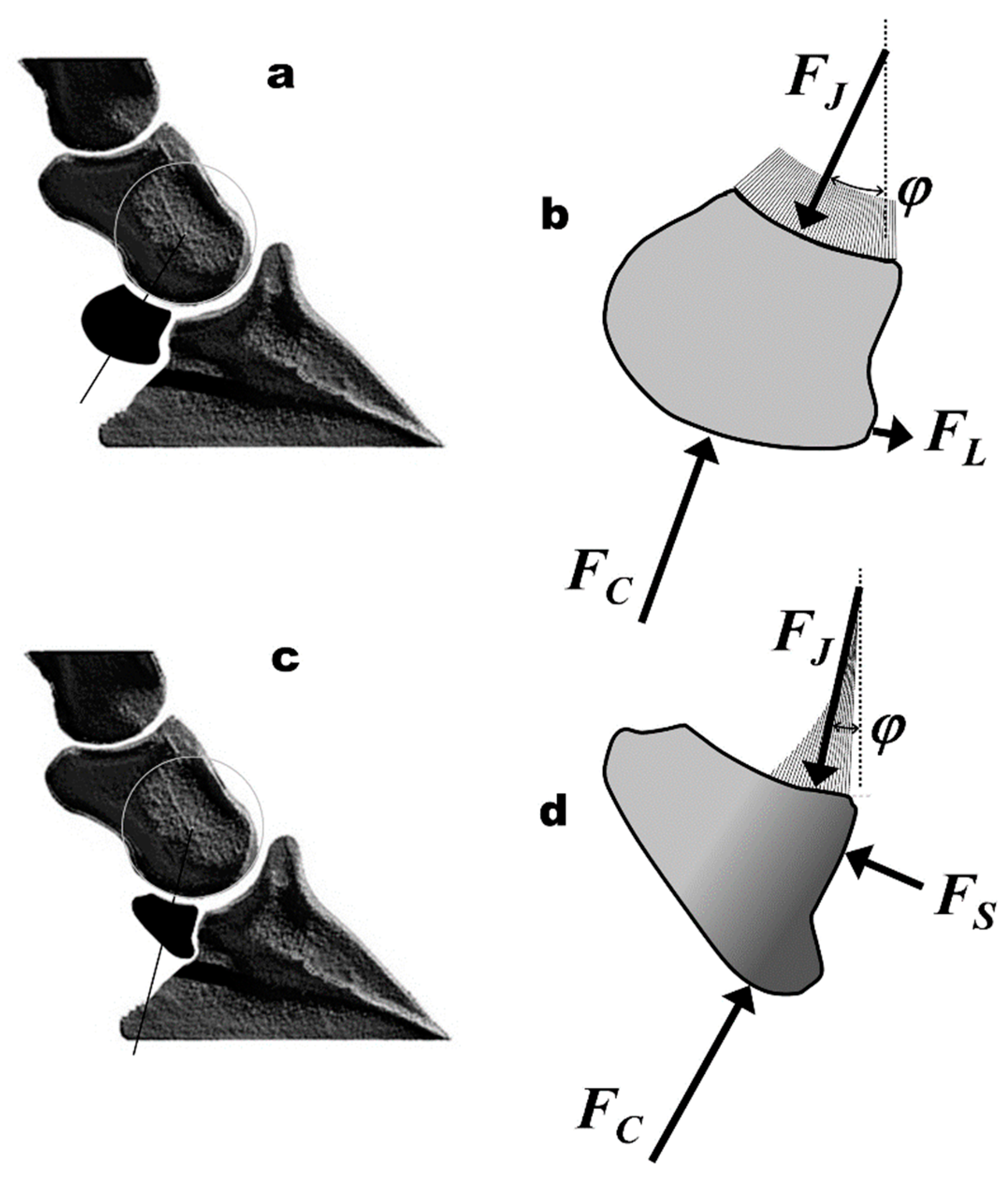

| Symbol(s) | Explanation |
|---|---|
| Abbreviations | |
| NMP | naviculo-mediophalangeal joint |
| NDP | naviculo-distophalangeal |
| DDFT | deep digital flexor tendon |
| COP | centre of pressure (origin of joint forces or ground reaction forces); position of the COP on the joint surface of the navicular bone: 0% at the proximal border, 100% at the distal border |
| FBD | free body diagram |
| r, r2 | coefficients of correlation and determination |
| p | probability (p-value) |
| A, B, C | components of multiple regression (B = squared semi-partial correlation; A + B and B + C = squared partial correlations) |
| R | radius |
| W | width |
| Coordinate system | |
| x | forward (cranial direction), parallel to the sole of the hoof |
| y | upward (proximal direction), perpendicular to the sole of the hoof |
| Angles of the navicular bone measured with respect to the coordinate syste m | |
| α | angle between the negative y-axis and the articular surface radius at the proximal border of the joint surface (α is negative) |
| β | angle between the negative y-axis and the articular surface radius at the distal border (negative angle when β opens on the proximal side of the y-axis) |
| γ | included angle of the joint surface (between proximal and distal border); γ = β − α |
| μ | position angle of the navicular bone; angle between the negative y-axis and the articular surface radius at the midpoint of the joint surface; μ = (α + β)/2 (μ is negative) |
| τ | angle between the negative x-axis and the DDFT proximal to the navicular bone |
| δ | angle between the positive x-axis and the DDFT distal to the navicular bone (negative when DDFT pointing upward towards phalanx III) |
| ε | included angle of the DDFT |
| λL | angle between x-axis and a line perpendicular to the distal impar sesamoid ligament |
| λS | angle between x-axis and the joint between navicular and hoof bone |
| Forces and pressure | |
| FJ | main joint force (acting from the middle phalanx towards the navicular bone; naviculo-mediophalangeal joint) |
| φ | angle between the negative y-axis and the joint force FJ (φ is negative because it lies on proximal side of y-axis) |
| FS | additional joint force from hoof bone to navicular bone (naviculo-distophalangeal joint) |
| FL | force of the distal impar ligament |
| FT | force of the DDFT |
| FC | compressive force of the navicular bone, resultant of distal and proximal FT |
| P | surface pressure on the navicular joint surface (contact stress between middle phalanx and the navicular bone) |
| P0 | maximal stress at the stress pole |
| Pdist | stress at the distal border of the navicular bone |
| Pprox | stress at the proximal border |
| Moment arms with respect to the rotation centre of the hoof joint | |
| p | moment arm of the DDFT proximal to the navicular bone |
| p50 | p at τ = 50° |
| d | moment arm of the DDFT distal to the navicular bone |
| sFS | moment arm of FS |
| sFL | moment arm of FL |
| Angles measured with respect to FJ and its COP | |
| ζ1 | angle between FJ and the articular surface radius at the distal border of the joint surface (ζ1 is positive, counter-clockwise) |
| ζ2 | angle between FJ and the articular surface radius at the proximal border (ζ2 is negative, clockwise) |
| η | angle between FJ and P0 |
| Angles measured with respect to P0 | |
| θ | angle between the articular surface radius at any point on the joint surface and P0 |
| θdist | angle between P0 and the articular surface radius at the distal border |
| θprox | angle between P0 and the articular surface radius at the proximal border |
| Mean | Standard Deviation | Minimum | Maximum | Range | |
|---|---|---|---|---|---|
| p50/d | 0.916 | 0.051 | 0.814 | 1.040 | 0.226 |
| sFS/d | 0.590 | 0.049 | 0.458 | 0.771 | 0.313 |
| sFL/d | 0.877 | 0.017 | 0.851 | 0.898 | 0.047 |
| λS (°) | 66 | 6.83 | 51 | 85.5 | 34.5 |
| λL (°) | 59.85 | 5.79 | 51 | 71 | 20 |
| δ (°) | 4.11 | 5.54 | −9 | 18 | 27 |
| α (°) | −42.39 | 7.58 | −63 | −20.5 | 42.5 |
| β (°) | −0.24 | 5.17 | −16 | 10 | 26 |
| γ (°) | 42.15 | 4.69 | 29.5 | 58 | 28.5 |
| μ (°) | −21.32 | 6.05 | −38 | −5.75 | 32.25 |
| MR 1 | MR 2 | MR 3 | MR 4 | MR 5 | MR 6 | MR 7 | MR 8 | MR 9 | |
|---|---|---|---|---|---|---|---|---|---|
| predictor a | α | γ | γ | μ | γ | μ | γ | μ | FJ |
| predictor c | β | μ | p50/d | p50/d | p50/d | p50/d | p50/d | p50/d | COP% |
| response variable | p50/d | p50/d | FJ | FJ | COP% | COP% | Pdist_eff | Pdist_eff | Pdist_eff |
| A + B + C r2 | 0.6172 | 0.6172 | 0.1465 | 0.3672 | 0.3232 | 0.7865 | 0.4628 | 0.5880 | 0.9270 |
| A + B + C p | <0.0001 | <0.0001 | <0.0001 | <0.0001 | <0.0001 | <0.0001 | <0.0001 | <0.0001 | <0.0001 |
| B + C r2 | 0.4313 | 0.5952 | 0.1326 | 0.1326 | 0.3083 | 0.3083 | 0.4511 | 0.4511 | 0.8030 |
| B + C p | <0.0001 | <0.0001 | <0.0001 | <0.0001 | <0.0001 | <0.0001 | <0.0001 | <0.0001 | <0.0001 |
| A + B r2 | 0.6139 | 0.2946 | 0.0879 | 0.3470 | 0.0395 | 0.0001 | 0.2077 | 0.0799 | 0.2574 |
| A + B p | <0.0001 | <0.0001 | 0.0007 | <0.0001 | 0.0167 | 0.4439 | <0.0001 | 0.0011 | <0.0001 |
| VIF | 2.61 | 2.61 | 1.2 | 1.6 | 1.5 | 4.7 | 1.9 | 2.4 | 13.7 |
| UX | 0.3828 | 0.3828 | 0.8535 | 0.6328 | 0.6768 | 0.2135 | 0.5372 | 0.412 | 0.073 |
| B | 0.4280 | 0.2726 | 0.0740 | 0.1124 | 0.0246 | −0.4781 | 0.1960 | −0.0570 | 0.1334 |
| A | 0.1859 | 0.0220 | 0.0139 | 0.2346 | 0.0149 | 0.4782 | 0.0117 | 0.1369 | 0.1240 |
| C | 0.0033 | 0.3226 | 0.0586 | 0.0202 | 0.2837 | 0.7864 | 0.2551 | 0.5081 | 0.6696 |
| trend 1 | proximal β, long p50/d | proximal μ, long p50/d | short p50/d, high FJ | short p50/d, high FJ | short p50/d, distal COP | short p50/d, distal COP | short p50/d, high Pdist | short p50/d, high Pdist | distal COP, high Pdist |
| trend 2 | proximal α, long p50/d | wide γ, long p50/d | small γ, high FJ | distal μ, high FJ | small γ, distal COP | ---- | small γ, high Pdist | distal μ, high Pdist | high FJ, high Pdist |
| MR justified: Y/N | Y | Y | Y | Y | Y | N | Y | N | N |
| justifi-cation if N | --- | --- | --- | --- | --- | C1 | --- | C1 | C2 |
| Mean | Standard Deviation | Minimum | Maximum | Range | |
|---|---|---|---|---|---|
| FJ/FT | 0.789 | 0.100 | 0.564 | 1.041 | 0.477 |
| FS/FT | −0.162 | 0.071 | −0.341 | −0.008 | 0.333 |
| FL/FT | 0.029 | 0.014 | 0.003 | 0.046 | 0.043 |
| φ (°) | −16.65 | 6.83 | −33.58 | −2.10 | 31.48 |
| COP (%) | 61.26 | 8.88 | 38.97 | 83.57 | 44.60 |
| ηeff (°) | 45.05 | 30.24 | −50.51 | 74.67 | 125.18 |
| ζ1 (°) | 16.41 | 4.55 | 7.72 | 30.52 | 22.80 |
| ζ2_eff (°) | −23.87 | 3.91 | −33.38 | −13.85 | 19.53 |
| θdist_eff (°) | −28.65 | 34.01 | −66.95 | 81.03 | 147.98 |
| θprox_eff (°) | −68.93 | 31.65 | −90 | 31.03 | 121.03 |
| P0_eff | 2.94 | 2.03 | 0.98 | 10.01 | 9.03 |
| Pdist_eff | 1.87 | 0.83 | 0.27 | 4.10 | 3.83 |
| Pprox_eff | 0.41 | 0.44 | 0 | 1.94 | 1.94 |
| γeff (°) | 40.28 | 6.68 | 23.05 | 58 | 34.95 |
| Variables | Ideal Case Figure 7a,b) | Adverse Case (Figure 7c,d) |
| morphological variables | influencing the biomechanical parameters | |
| included joint surface angle γ (proximodistal extent) | wide (>40°) (long) | small (<40°) (short) |
| proximodistal position μ | proximal (>20°) | distal (<20°) |
| shape factor p50/d | 0.9–1 (rectangular or trapezoid) | <0.9 (cuneiform or wedged) |
| biomechanical variables | influenced by the morphological parameters | |
| navicular joint force (FJ/FT) | small (<0.75) | large (>0.85) |
| force of navicular–hoof bone joint (FS/FT) | 0 | large (>0.2) |
| location of COP | 50% (central) | >67% (distal) |
| pressure distribution | even | uneven (distal stress peak) |
| Pdist_eff (Figure 6) | moderate (~1) | high (>2.5) |
| Pprox_eff (Figure 6) | moderate (~1) | 0 |
Disclaimer/Publisher’s Note: The statements, opinions and data contained in all publications are solely those of the individual author(s) and contributor(s) and not of MDPI and/or the editor(s). MDPI and/or the editor(s) disclaim responsibility for any injury to people or property resulting from any ideas, methods, instructions or products referred to in the content. |
© 2024 by the author. Licensee MDPI, Basel, Switzerland. This article is an open access article distributed under the terms and conditions of the Creative Commons Attribution (CC BY) license (https://creativecommons.org/licenses/by/4.0/).
Share and Cite
Fuss, F.K. Joint Stress Analysis of the Navicular Bone of the Horse and Its Implications for Navicular Disease. Bioengineering 2024, 11, 87. https://doi.org/10.3390/bioengineering11010087
Fuss FK. Joint Stress Analysis of the Navicular Bone of the Horse and Its Implications for Navicular Disease. Bioengineering. 2024; 11(1):87. https://doi.org/10.3390/bioengineering11010087
Chicago/Turabian StyleFuss, Franz Konstantin. 2024. "Joint Stress Analysis of the Navicular Bone of the Horse and Its Implications for Navicular Disease" Bioengineering 11, no. 1: 87. https://doi.org/10.3390/bioengineering11010087
APA StyleFuss, F. K. (2024). Joint Stress Analysis of the Navicular Bone of the Horse and Its Implications for Navicular Disease. Bioengineering, 11(1), 87. https://doi.org/10.3390/bioengineering11010087






